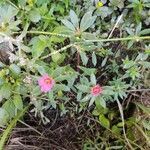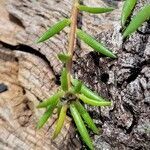Annual herb, succulent; stems ascending or prostrate, to 20-30 cm long, glabrous, but usually with conspicuous nodal tufts of 3-7 mm long, white hairs. Leaves alternate, sessile or subsessile; blade terete, somewhat flattened, linear, linear-or oblong-lanceolate, 5-16(-27) x 1-4 mm, glabrous. Inflorescence of terminal, solitary or clustered, sessile flowers, surrounded by long brownish or whitish hairs and an involucre of 6-10 leaves. Sepals somewhat unequal in size and shape, triangular-ovate to ovate, 2-5 mm long, not keeled, acute, apiculate; petals rose-purple, reddish or purple-pink, obovate, oblong-obovate, or broadly ovate, 3-6 x 2.5-4.5(-6) mm, sometimes retuse; stamens 15-37, filaments crimson, 2-2.5 mm long; style 2-2.5 mm long, stigmas 3-6. Fruit ovoid or subglobose, to 7 x 2.5-4.3 mm, rich yellowish-brown and glossy above, circumscissile at about middle; seeds lenticular-reniform, 0.5-0.7 mm wide, black, dull or shining, minutely tuberculate.
Herbs annual or perennial, 5-20 cm. Stems not articulated, densely caespitose, diffuse, much branched; leaf axils densely pilose. Leaves alternate; petiole absent; leaf blade terete-linear or subulate-lanceolate, 10-20 × 1-4 mm, apex acute. Flowers more than ca. 2 cm in diam., surrounded by involucre of 6-9 bracts and dense wool. Sepals oblong, apex acute or acuminate. Petals 5, red-purple, broadly obovate, connate at base, apex obtuse or slightly retuse. Stamens 20-30; filaments red, free. Style short; stigma 3-6-lobed. Capsule glossy straw colored apically, cylindric-ovoid, ca. 3 × 2.5 mm. Seeds black, with very slight purplish iridescence when mature, 0.5-0.7 mm; testa cells interlocking, domed to conic-tuberculate. Fl. and fr. May-Aug.
Plants annual; roots fibrous to slightly fleshy. Stems prostrate, suberect to erect, succulent; trichomes conspicuous at nodes and in inflorescence; branches 3-25 cm. Leaf blades linear to oblong-lanceolate, terete to hemispheric, 5-20 × 1-3 mm, apex acute; involucrelike leaves 6-9. Flowers 5-12 mm diam.; petals dark pink to purple, obovate, 3-5(-7) × 1.5-3 mm; stamens 5-12(-37); stigmas 3-5(-6). Capsules ovoid, 1.5-4.3 mm diam. Seeds black or leaden, orbiculate (0.4-)0.5-0.6 mm diam.; surface cells loosely arranged, short-tuberculate and stellate to rounded-stellate; tubercles long or absent. 2n = 8, 16.
An annual herb. It is soft and succulent. It has a taproot and can keep growing for a few years. It lies along the ground. It is 5-20 cm high and 30-50 cm wide. The leaves are narrow and hairy. They are 10-20 mm long by 1-4 mm wide. The flowers are pink or yellow. They are small and about 2 cm across. The fruit is a straw yellow capsule with very tiny seeds.
Variable herb. Leaves spirally arranged, obovate to linear, 2-30 mm long, with axillary hairs. Capituli 1-12-flowered. Flowers surrounded by bracteoles and hairs. Petals 4-6. Stamens (6-)10-75. Style arms 4-8. Fruit ovate, globular or obovate; operculum ½ to ¾ as high as the fruit. Seeds ∞; testa cells elliptic to stellulate.
Flat, creeping succulent. Stems pinkish with white hairs. Leaves fleshy, light green. Flowers pink or crimson.







